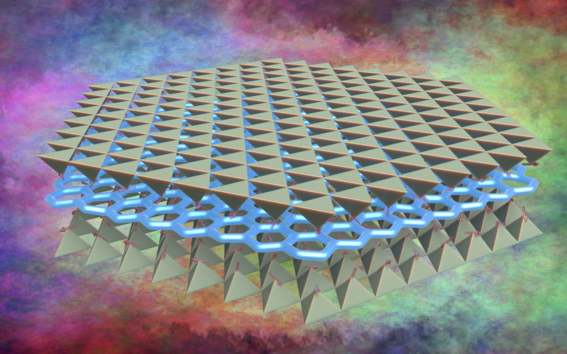New quantum entangled material could pave way for ultrathin quantum technologies

The paper 'Nature of the Unconventional Heavy-Fermion Kondo State in Monolayer CeSiI' as described in this article was featured on the front cover of Volume 24, Issue 14 of Nano Letters, published on April 10, 2024.
Two-dimensional quantum materials provide a unique platform for new quantum technologies, because they offer the flexibility of combining different monolayers featuring radically distinct quantum states. Different two-dimensional materials can provide building blocks with features like superconductivity, magnetism, and topological matter. But so far, creating a monolayer of heavy-fermion Kondo matter – a state of matter dominated by quantum entanglement – has eluded scientists. Now, researchers at Aalto University have shown that it’s theoretically possible for heavy-fermion Kondo matter to appear in a monolayer material, and they’ve described the microscopic interactions that produces its unconventional behavior. These findings were published on February 23, 2024 in Nano Letters.
“Heavy-fermion materials are promising candidates to discover unconventional topological superconductivity, a potential building block for quantum computers robust to noise,” says Adolfo Fumega, the first author of the paper and a post-doctoral researcher at Aalto University.
These materials can feature two phases: one analogous to a conventional magnet, and one where the state of the system is dominated by quantum entanglement, known as the heavy-fermion Kondo state. At the transition between the magnetic phase and the heavy-fermion state, macroscopic quantum fluctuations appear, leading to exotic states of matter including unconventional superconducting phases.
Traditionally, heavy-fermion compounds have been studied in bulk materials. Previous investigations carried at Aalto University by the Atomic Scale Physics and Correlated Quantum Materials groups provided the first theoretical and experimental demonstrations of heavy-fermion Kondo matter in van der Waals heterostructures. Two of these papers were published in Nature and Physical Review Letters in 2021.
However, an intrinsic heavy-fermion state in a van der Waals monolayer has remained elusive. Layered van der Waals materials offer new degrees of freedom such as stacking of different layers to engineer heterostructures, twisting the layers to create moiré patterns or applying electric gate voltages, strategies allowing to explore and engineer the different phases of heavy-fermion materials in a controlled way.
The monolayer material researchers analyzed is monolayer CeSiI, a compound that has been recently isolated in the ultrathin limit. Using a combination of many-body and quantum chemistry methods, they showed the nature of competing quantum magnetic interactions in the material, demonstrating that such competition leads to an unconventional quantum entangled state. Furthermore, they showed that the quantum magnetism in this material is dominated by relativistic effects, leading to a subatomic magnetic structure radically different from other two-dimensional materials.
“The discovery of a heavy-fermion quantum material monolayer establishes a fundamental building block for quantum devices,” says Jose Lado, an assistant professor at Aalto University who also heads the Correlated Quantum Materials research group.
Bulk heavy-fermion materials are greatly challenging from the material science point of view, and making devices out of them is a nearly impossible task. With a purely two-dimensional heavy-fermion quantum material and the flexibility of stacking van der Waals layers, a whole new family of quantum devices based on exotic heavy-fermion Kondo phenomena may be developed, opening up yet unexplored directions in quantum technologies.
Full paper:
Adolfo Fumega, Jose Lado, Nature of the Unconventional Heavy-Fermion Kondo State in Monolayer CeSiI, Nano Letters, https://doi.org/10.1021/acs.nanolett.4c00619, (2024).
Contact:

Read more news

Your voice gives away valuable personal information, so how do you keep that data safe?
With speech technologies becoming increasingly common, researchers want to make sure we don’t give away more information than we mean to.
Aalto in 2025: Quantum leaps, creative breakthroughs and solutions for a better life
Growth, technology and industrial renewal; human-centred solutions; health and everyday wellbeing; and enjoyable daily life and thriving communities.
Research Council of Finland establishes a Center of Excellence in Quantum Materials
The Centre, called QMAT, creates new materials to power the quantum technology of coming decades.






